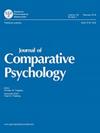测试猕猴社会容忍度在跟随人眼注视能力中的作用。
IF 1.1
4区 心理学
Q4 BEHAVIORAL SCIENCES
引用次数: 0
摘要
对R. Bettle和A. G. Rosati文章的评论(见记录2022-45647-001)。在非人类灵长类动物中,对受试者跟随人类目光的能力的测试已经得到了很好的研究,这是Bettle和Rosati在本期专题文章中提到的问题。正如Bettle和Rosati所描述的那样,来自马基雅维利智力假说的竞争假说预测,更具竞争力和侵略性的物种将表现出更强的使用眼神等线索的能力。与此相反,耐受性假说预测,耐受性和亲和性更强的物种将表现出更强的利用这些线索的能力。贝特尔和罗萨蒂用同样的方法对巴巴里猕猴进行了测试。与恒河猴相比,巴巴里恒河猴具有相对的忍耐力和高度的亲和力。重要的是,作者对视频记录的数据进行了盲编码,具有较高的观察者间可靠性。研究人员发现,巴巴里猕猴也能够跟随人类的目光:尽管在没有障碍的情况下,大约有一半的猕猴向上看并跟随人类的目光,但在有障碍的情况下,只有三分之一的猕猴向上看,在这种情况下,它们看不到人类在看什么。这些结果与之前对恒河猴进行的研究相当,表明宽容和不那么竞争的物种实际上表现出相似的技能。(PsycInfo Database Record (c) 2022 APA,版权所有)。本文章由计算机程序翻译,如有差异,请以英文原文为准。
Testing the role of macaque social tolerance in ability to follow human eye gaze.
Comments on an article by R. Bettle and A. G. Rosati (see record 2022-45647-001). The testing of subjects' abilities to follow human eye gaze has been particularly well studied in nonhuman primates, and this is the question addressed by the Featured Article for this issue by Bettle and Rosati. As described in Bettle and Rosati, he competition hypothesis, stemming from the Machiavellian Intelligence Hypothesis, predicts that species that are more competitive and aggressive will exhibit greater ability to use cues like eye gaze. The tolerance hypothesis, conversely, predicts that species that are more tolerant and affiliative will exhibit greater ability to use these cues. Bettle and Rosati tested Barbary macaques with identical methods. Compared to rhesus macaques, Barbary macaques are relatively tolerant and highly affiliative. Importantly, the authors coded the video-recorded data blind and with high interobserver reliability. The authors found that Barbary macaques were also able to follow human eye gaze: Although roughly half the individuals looked up and followed human's eye gaze in the no barrier condition, only a third looked up in the barrier condition where they could not see what the human was looking at by doing so. These results were quite comparable to the earlier study conducted with rhesus macaques, suggesting that tolerant and less competitive species actually show similar skills. (PsycInfo Database Record (c) 2022 APA, all rights reserved).
求助全文
通过发布文献求助,成功后即可免费获取论文全文。
去求助
来源期刊
CiteScore
3.30
自引率
7.10%
发文量
0
审稿时长
>12 weeks
期刊介绍:
The Journal of Comparative Psychology publishes original research from a comparative perspective
on the behavior, cognition, perception, and social relationships of diverse species.

 求助内容:
求助内容: 应助结果提醒方式:
应助结果提醒方式:


